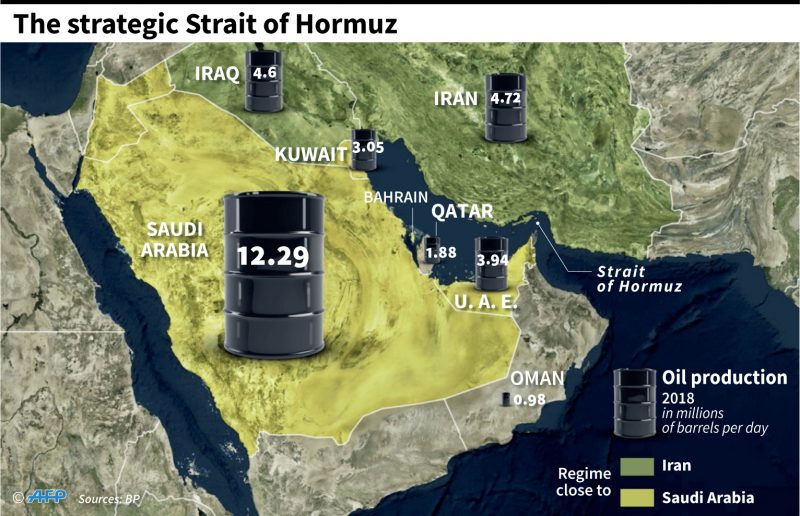Strait of Hormuz: key waterway under pressure
The strategic Strait of Hormuz (Jean-Michel CORNU)
Paris (AFP) – The Strait of Hormuz, located in the area where Iran shot down a US military drone, is a strategically important waterway for the world’s oil transits, which lies at the heart of regional tensions.
Iran warned on Friday it would “decisively defend its territory” against eventual US retaliation, while the airlines KLM, Lufthansa, Malaysia Airlines, Qantas and Singapore Airlines said they were suspending flights over the strait.
Some background:
– Gateway to the Gulf –
The Strait of Hormuz links the Gulf to the Gulf of Oman and is situated between Iran and Oman.
It is vulnerable due to its narrowness — some 50 kilometres (30 miles) — and its depth of no more than 60 metres (200 feet).
The corridor is dotted with sparsely inhabited or desert islands, which are strategically important, notably the Iranian islands of Hormuz, Qeshm and Larak.
– Oil transit hotspot –
The strait is a vital corridor connecting the petroleum-rich states of the Middle East with markets in Asia, Europe, North America and elsewhere.
According to the US Energy Information Administration (EIA), in 2018 nearly 21 million barrels of crude a day transited the strait.
That represents around 21 percent of world oil consumption and one-third of total global seaborne oil transit.
A quarter of global liquefied natural gas trade also transited Hormuz, the EIA said.
Around 76 percent of the crude transiting the strait was destined last year for Asia, mainly China, India, Japan and South Korea.
While Saudi Arabia and the United Arab Emirates have established a network of pipelines that can use alternative routes, they only allow the export of limited amounts — around three million barrels a day in 2018, with a total capacity of 6.8 million.
These pipelines too are vulnerable, as shown by the attack on a Saudi pipeline in May by Yemeni rebels.
Recent attacks on two tankers in the Gulf of Oman, and the shooting down of the US drone by Iran, have raised the prospect of significant disruptions to shipping and destabilisation of the world oil market: oil prices soared more than six percent Thursday in New York.
For consumer countries it would be difficult to find an alternative in volume and quality terms to Gulf crude. So-called light crude produced by the United States is not a substitute for the Middle East’s heavy crude.
The United States, the world’s largest global crude oil producer and exporter, imported around 1.4 million barrels per day of crude which had transited the Strait of Hormuz, seven percent of its consumption.
– Zone of tension, conflict –
Iran’s Revolutionary Guard, the ideological army of the Islamic republic, controls naval operations in the Gulf.
Tehran repeatedly criticises the presence of foreign powers in the region, notably the US Fifth Fleet stationed in Bahrain, and it has regularly threatened to close the strait if it comes under attack.
One of the major disruptions to oil transit came in 1984 during the Iran-Iraq war (1980-1988) when more than 500 vessels were destroyed or damaged in the so-called “Tanker War”.
In 1988, an Iran Air flight from Tehran to Dubai, via Bandar Abbas, was shot down by missiles fired from a US Navy cruiser patrolling the strait. All 290 people on board were killed.
The crew of the USS Vincennes said they mistook the Airbus for an Iranian fighter.
In April 2015 the Revolutionary Guards boarded and took into custody in the strait a container ship flying the flag of the Marshall Islands.
The following month Revolutionary Guard sailors fired warning shots in an apparent bid to intercept a Singapore-flagged cargo ship in the Gulf.
Stoked by the US withdrawal in May 2018 from the landmark nuclear deal between Iran and world powers, and the reimposition of heavy US sanctions on Tehran, tensions have recently escalated in the Gulf region.
Washington has blamed sabotage and attacks on oil tankers in the Gulf in May and June on Tehran, which denies involvement.
Disclaimer: Validity of the above story is for 7 Days from original date of publishing. Source: AFP.


